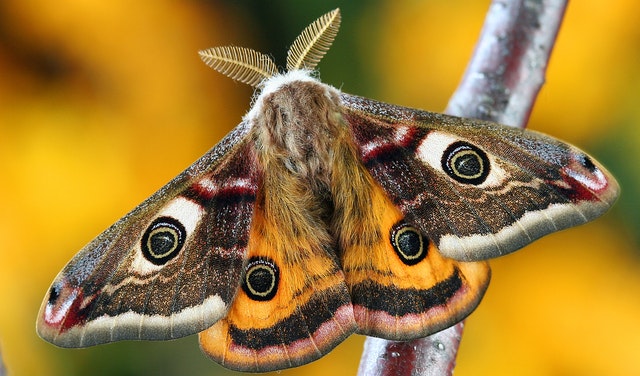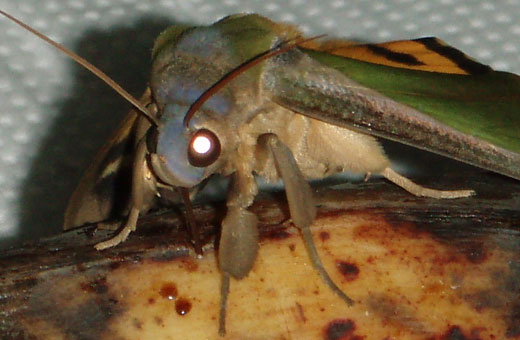
Moth Fun Facts
All of us have seen moths around our homes, near lights at night. While they look like the drab relatives of the more beautiful butterflies, there is much more to them than meets the eyes. Here are some fun facts about these almost omnipresent insects.
1. Moths outnumber butterflies 9:1
Both moths and butterflies belong to the order Lepidoptera, but over 90% of them are moths. There are over 160,000 species known so far and probably many that are still not known. Butterflies end up getting a lot more attention because we see them during the day while moths, though being more in number, are mostly nocturnal and therefore given less attention.
2. Moths are also colourful
While many moths are drab and brown in colour, there are many species which are colourful and beautiful. They can be pink, black, red, yellow, or brown. Their colours are used as camouflage, to resemble the bark of a tree or a twig, or to scare off predators.
3. Some Moths do not have mouths
Yes! You heard that right. Some moths do not have mouths. How do they eat? They don’t. These moths, like the luna moth, take up a lot of energy during the caterpillar stage and store it in their bodies (destroying crops and trees in the process). They have a short lifespan, a few days, which they use to reproduce before they die. As such, there is no need for any extra energy and thereby no need for a mouth.
This is the reason why many moth caterpillars are some of the biggest agricultural pests in many parts of the world.

Pic credit:wikipedia
Did you Know? The study of Moths (and Butterflies) is known as ‘lepidoptery’, and biologists that specialize in either are called ‘lepidopterists’.
4. Moths can ‘see’ UV rays
Moths have compound eyes and simple eyes. Many lenses help focus light from the various fields of view to form image. They can see ultra violet ray as well, unlike humans. At the caterpillar stage however, they can barely see and mostly can differentiate only between dark and light.
5. Moths vary greatly in size
There are many moths with a span of only a few millimeters while some have a huge wingspan. The Stigmella maya is one of the most petite moths known to scientists with a wingspan of 2.5mm. The Atlas Moth, on the other hand, is one of the largest moths and also one of the most beautiful. It has a wingspan of around 11 inches (28 cm)! It is found in tropical and subtropical forests of Southeast Asia.
Want to know more about insects? Read 10 Interesting Facts About Insects
6. Moths have very long tongues
Moths use long proboscis, which are tongue like structures, to suck nectar or other fluids. In some moths, these are very long and are tightly coiled when not in use. The Hummingbird Moth has a proboscis that is longer than its whole body. Some moths like the Darwin’s Hawk moth of Madagascar has a proboscis which is nearly 13 inches long!
7. Vampire Moths are real
It is true! Vampire moths do exist and as their name suggests, they do bite and suck blood. Vampire moths have a proboscis, which they use to repeatedly penetrate the skin until blood is accessible. The pressure from the blood then helps move the blood from the animal to the moth. Only the male vampire bats suck blood. It is believed that they do so to get sodium content in their bodies.

pic credit: itsnature.org
The good news is that while the bite may hurt, but unlike mosquitoes, vampire moths are not known to transmit any diseases.
Also Read 10 Interesting Fact Series about Dinosaurs, Dogs, Earth, Ocean Animals etc
8. Male Moths have a strong sense of smell
The feathery antennae of moths enable them to sense chemicals in their environment, which is technically how they ‘smell’. This is called chemoreception. Male moths have a strong ability to sense pheromones from female moths up to large distances. Male silk moths are known to have the strongest sense of smell among moths. They have large, elaborate, feathery antennae that are filled with scent receptors enabling them to sense a single pheromone scent particle from a female for around 11km (7miles)!!!
9. Moths are attracted to bulbs and beer
We all know that moths are attracted to light. However, fermented food like stale beer, molasses and ripe bananas also attract moths. So if you want to catch or observe one, just put some stale beer near a lamp. They don’t seem to be as drab now, do they?
10. Some moths migrate
While we are aware of migratory birds and have probably seen them as well, not many of us know about migratory moths. They migrate to get better food supply or avoid harsh climate. Black cutworm moths spend their winters on the Gulf Coast in US but migrate north in the spring. Hummingbird hawk moth migrates from Mediterranean or North Africa all the way to Britain.
Book Recommendation

TIP Education has affiliate partnerships. These do not influence editorial content, though TIP Education may earn commissions for products purchased via affiliate links.

I really enjoyed reading this as I love to learn more about nature around us and I knew very little about moths. This was fascinating!
LikeLike
Thank you. I’m glad you liked it.
LikeLike